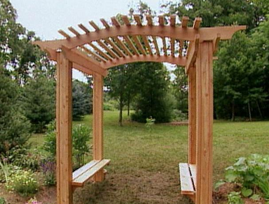If you do not want to put up a traditional structure like a Pergola, Arbor or Gazebo, but are still searching for something to provide protection from the sun over the summer, then you should really consider the shade sail. These are becoming more are more popular across Australia as a beautiful and functional alternative. Australians are choosing the shade sail over traditional roofing and laserlite over their decks, over the carports and they are sensational as shade providers if you have a backyard pool or play area for your children. In fact, the shade sail can cut up to 90% of direct UV rays depending on the type of material you choose*.
Below are some of the tips and thoughts to consider when planning your shade sail.
Location and supports
One of the first things you will need to do is plan where your shade sails are going to go. You probably already have a fairly good idea about this, so then it is a matter of determining where your support structures will go. There are several options you can choose from. If you have a house large tree or other fixed load bearing structure, you can use this as one or more of the anchor points for your shade sail. Knowing the location of these supports is important, as it will influence the placement of your other posts and the size of the sail.
If you are going to install the sails yourself, you will need to ensure that the posts or structures that you plan to use are load bearing.
Ideas, colours and design
At this point you will need to select your design. There is a great photo idea video on YouTube here. This shows a number of different options that you can think about in designing what colours and design you are interested in.
In terms of design consider a large twisted oblong, multiple triangles, two overlapping sails, as a start. The number of different shapes and designs possible is what makes these shade sails so versatile. If you are able, ensure your sails have a twist, this reduces the impact of leaf build up, they wont store water when it rains and as long as put up correctly should be able to withstand strong winds.
Approval
With your design all ready to go, it is worthwhile contacting your local council to confirm that you do not need to get official approval. For most designs you will not need to, but as always it is worth checking first.
Purchasing your sails and installation
If you are doing it yourself, ensure that you have point to point measurements to make sure your sail is going to fit. Talk to the sail cloth provider and get their advice as to the size and shape, if you have a drawing and photo, take them along to give them an even better idea. The more you discuss your plan the more likely you will get the best outcome.
When buying the sail cloth, ensure that you ask about its tendency to stretch, as cheaper materials will do this, and you will end up with a baggy sail shade which flaps around in the wind rattling at its posts. Ask to see different material swatches and query their fade resistance and lifespan.
When installing your sail, ensure that you have a good angle on the sail so that rain water runs off and that you have enough tension in your sale to allow for a curve. Get the tension nice and firm so that it doesn’t flap and follow the instructions supplied, using the correct fittings and fixtures for your sail.
For all your sail shade needs, including posts, fixtures and sails, check out the DIY Bargain Bin Pergola, Gazebo and Sun Shade section.
* Remember that you should wear sunscreen, hat and shirt even if you are in the shade, due to indirect and reflected UV.










